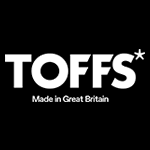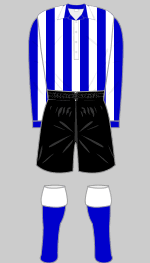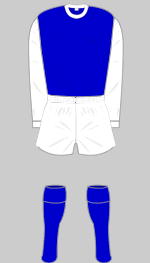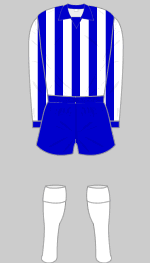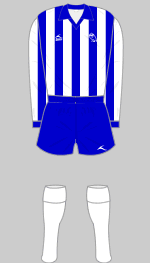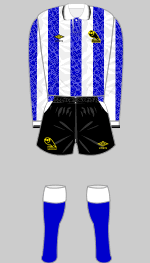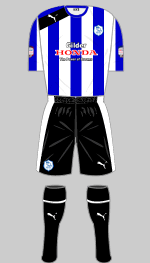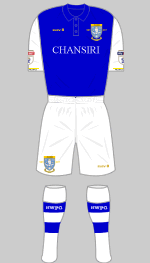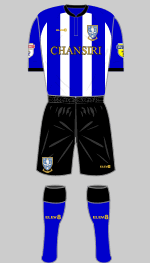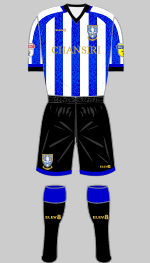Kit History
The Wednesday
1867
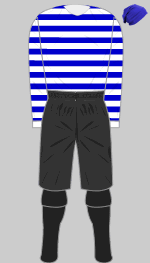
1872-1876 y D

1878-1881 a k n

1881-1886
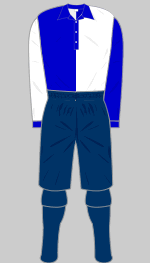
1886-1890 a k s z

1890-1891 a
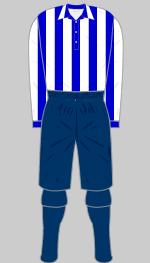
1891-1899 a b g k
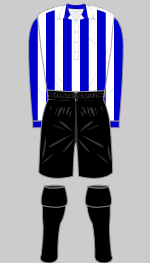
1900-1903 a e k v
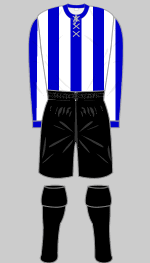
1903-1904 v
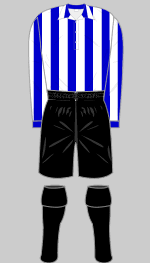
1904-1905 v
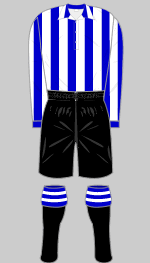
1905-1910 a b k v
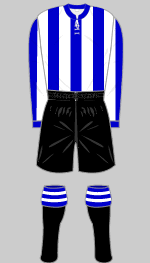
1910-1918 a k
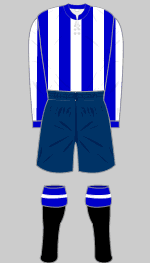
1920-1921 a k

1921-1922 a
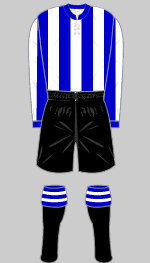
1922-1924 a v

1924-1930 a k t v
Sheffield Wednesday
1929
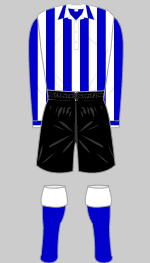
1930 v
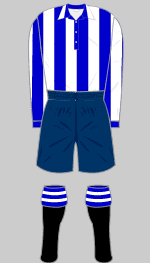
1932-1933 a
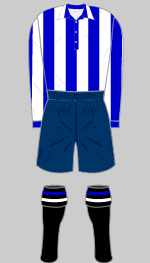
1933-1934 v
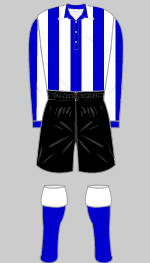
1934-Feb 1935 k
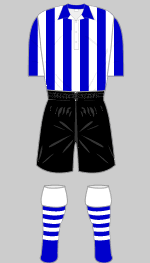
March 1935-1936 v

Oct 1936 t
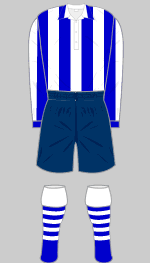
1936-1939 b f k
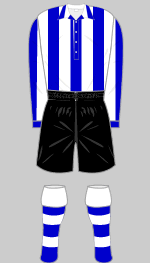
1939-1940 a k
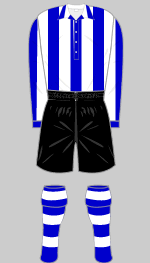
1942-1943 a k
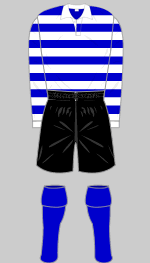
1945-1946 a h k
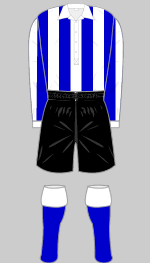
1946-1947 a b k t

1949-1953 d k
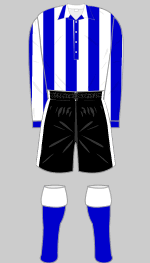
1953-1954 v
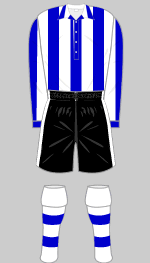
1954-1955 a

1955-1958 b d i k
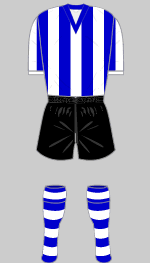
1958-1961 i s

1961-1962 i s
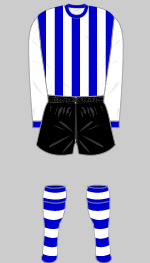
1961-1962 late i s C
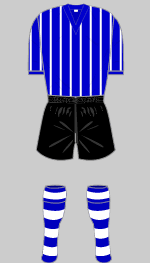
1962-1963 early q s
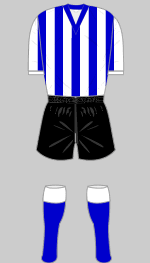
1962-1963 v
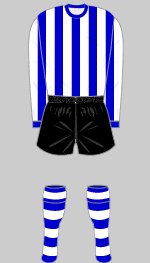
1963-1965 k s v

Aug-Nov 1973 l
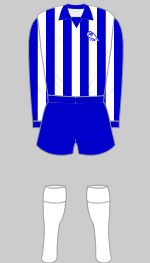
Nov 1973-1974 x

1974-1975 l
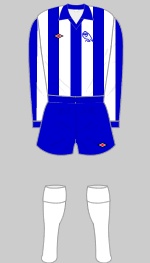
1975-1977 l

1977-1978 l A B
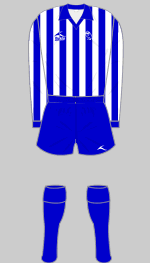
1983-March 1984 x
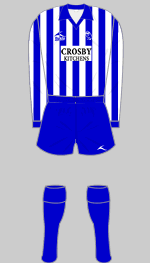
March-May 1984 1 x B
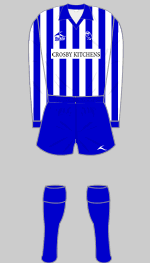
March-May 1984 2 x B
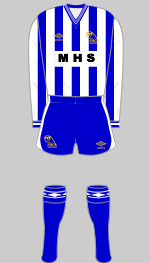
1984-1986 c
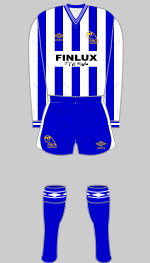
1986-1987 c
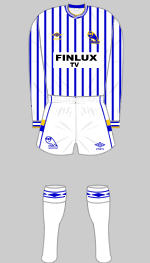
1987-1988 c j p
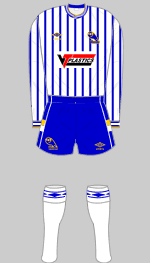
1988-1989 c p

1989-1990 c j m B
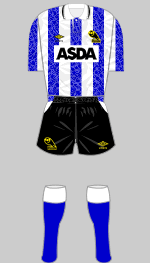
April 1991 B
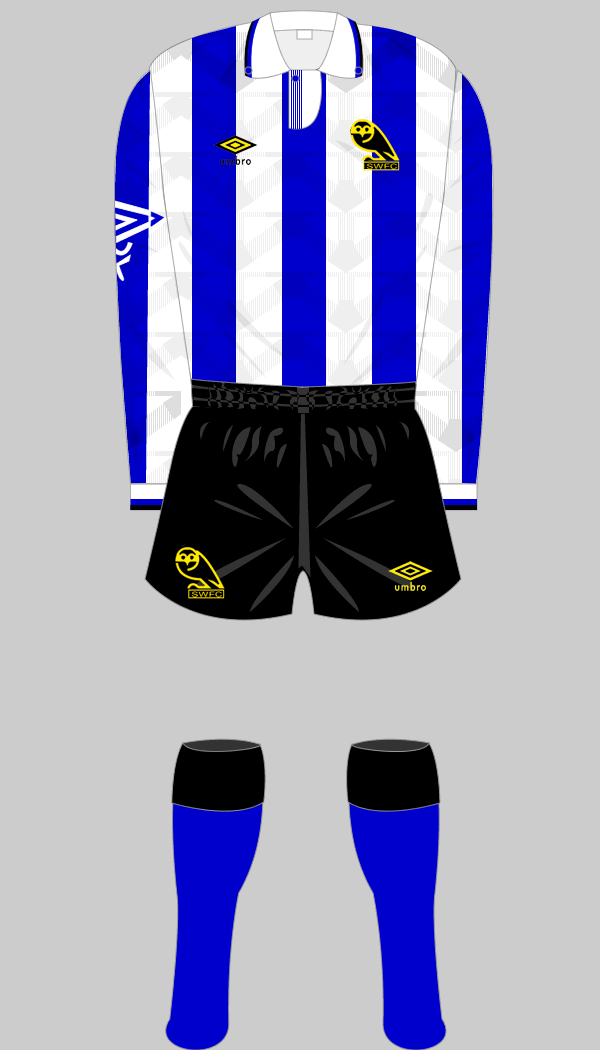
Aug-Dec 1991 w B
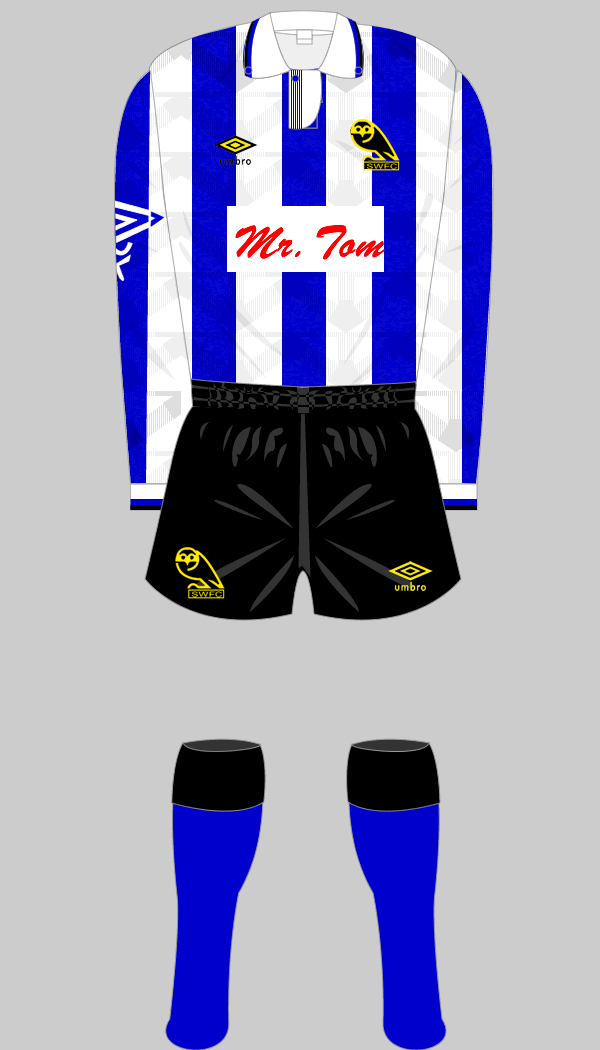
Jan-May 1992 c w B
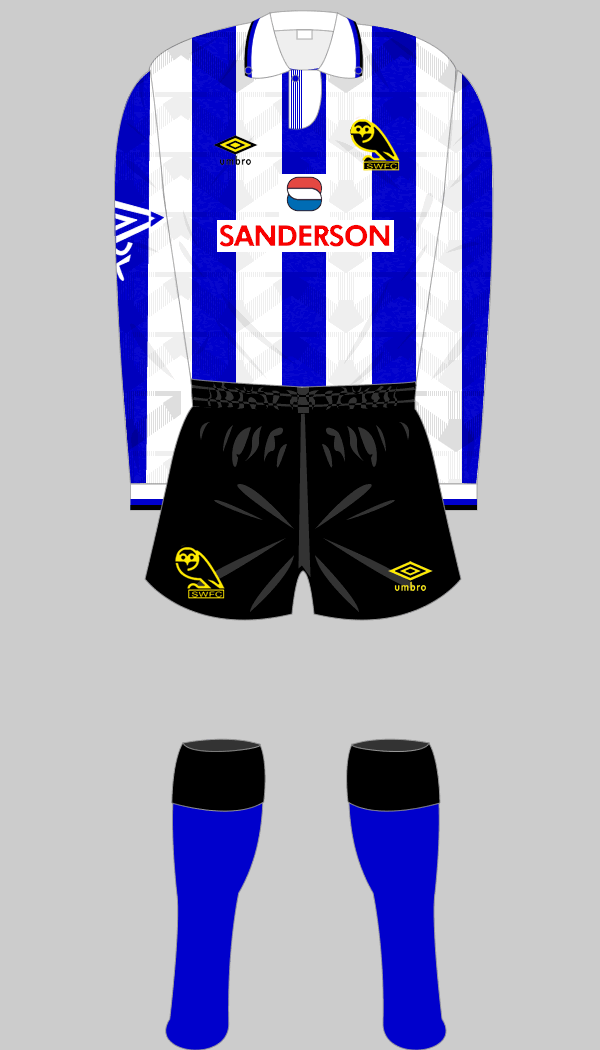
1992-1993 c B F
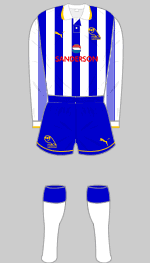
1993-1995 c
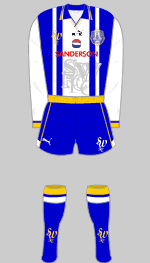
1995-1997 c j o
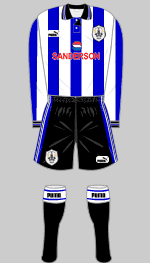
1997-1998 c o
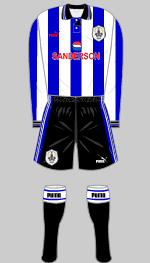
1998-1999 w

1999-2000 c
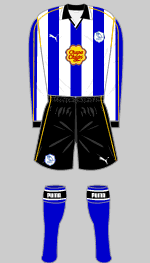
2000-2001 c

2001-2003 c j
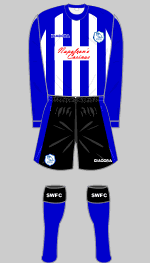
2003-2005 b j
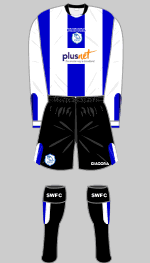
2005-2007 b
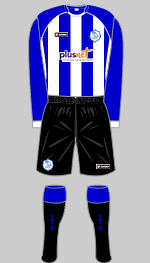
2007-2008 b
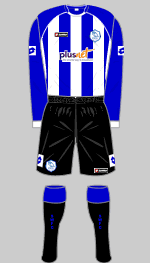
2008-2009 b
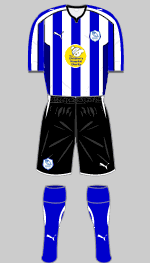
2009-2011 b
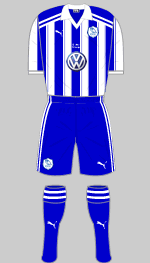
2011-2012 b
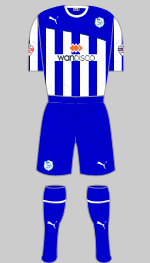
2013-2014 b
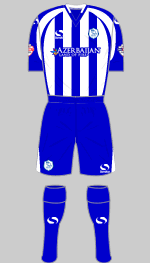
2014-2015 b
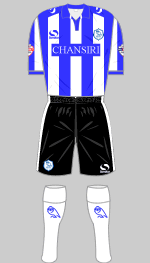
2015-2016 b
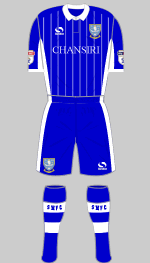
2016-2017 b
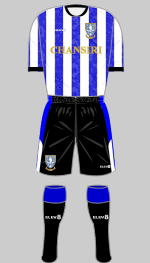
2020-2021 b
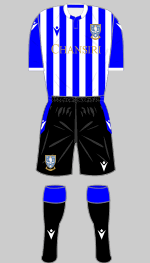
2021-2022 b
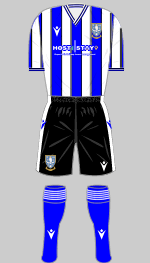
2022-2023 b
Background
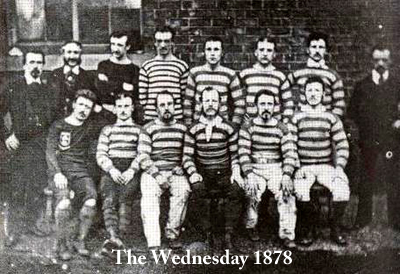 Sheffield is the crucible of
football, boasting the world's oldest clubs, Sheffield FC and Hallam FC
formed in 1857 and 1860 respectively. On Wednesday 4th September 1867
the Wednesday Cricket Club formed a football branch to keep members together
during the winter season. The cricket team played on Wednesday afternoons
when members, craftsmen, shopkeepers and clerks, had a half day off work. The new club
was officially named The Wednesday Cricket & Football Club. Although
they were frequently referred to as Sheffield Wednesday, the club did
not formally adopt this title until 1929.
Sheffield is the crucible of
football, boasting the world's oldest clubs, Sheffield FC and Hallam FC
formed in 1857 and 1860 respectively. On Wednesday 4th September 1867
the Wednesday Cricket Club formed a football branch to keep members together
during the winter season. The cricket team played on Wednesday afternoons
when members, craftsmen, shopkeepers and clerks, had a half day off work. The new club
was officially named The Wednesday Cricket & Football Club. Although
they were frequently referred to as Sheffield Wednesday, the club did
not formally adopt this title until 1929.
In their first ever game, The Wednesday defeated the Mechanics Club by three goals and four "rouges" to nil. Under "Sheffield Rules", the goal posts were four yards apart and a second pair of vertical posts stood four yards to either side. If the ball passed between these outer posts and was touched down by the attacking side, a rouge was scored: if teams finished level on goals, the one with the most rouges was the winner. The club's colours were royal blue and white although this was before the introduction of uniform kits. Players initially wore whatever they had to hand adorned by royal blue caps, scarves or sashes but by 1872, they registered ther colours as blue and white hoops.
A press report of a match on 14 January 1876 describes the team as wearing "blue striped jerseys and smuggler's caps, look(ing) all the world like Dutch sailors." The team photograph from three years later reproduced above shows various styles of jersey and two players are wearing self-coloured tops one of which bears what may be the crest of the Sheffield FA. Furthermore various knickerbockers, ducks and hose are apparent. This motley appearance was typical of the period when players provided their own kit.
In The Romance of the Wednesday 1867-1926, the author records that Wednesday wore "blue and white quarters like Blackburn Rovers" in 1886-87. In 1890 their shirts were described as "blue and white butcher's stripes."
By 1883 the club was one of the strongest in the
country and the footballers split from the cricket club arguing that they
earned all the money while the cricketers merely spent it. In 1886 the
club secretary forgot to submit Wednesday's application to the English
FA Cup in time and several leading players defected to a local works side,
Lockwood Brothers FC in order to play in the competition. They then threatened
to form a breakaway professional club, Sheffield Rovers, but after protracted
negotiations they were persuaded to return to The Wednesday in return
for payment of 5 shillings (25p) per home game and 7/6d (37.5p) for an
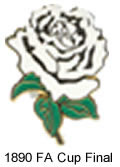 away game. On 22 April 1887, The Wednesday formally became a professional
team.
away game. On 22 April 1887, The Wednesday formally became a professional
team.
Wednesday were overlooked when the Football League was founded in 1888 so the club president formed the rival Football Alliance in 1889, winning the championship at the first attempt. They also reached the FA Cup final, the first Yorkshire team to do so, but were beaten by Blackburn Rovers. A white rose was embroidered onto the pale blue shirts worn in this match.
In 1892 the Alliance was incorporated into the Football League as Division Two and in the process The Wednesday were elected to play in Division One. After two consecutive semi-final appearances The Wednesday won the FA Cup in 1896. After a single season in Division Two (1898-99) the club were First Division champions in 1903 and 1904 and won the FA Cup again in 1907.
Wednesday's original nickname was "The Blades" until 1903 when they adopted "The Owls" and their original soubriquet was taken up by their rivals, Sheffield United.
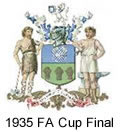 In 1920 the club were again relegated but returned
as Division Two champions in 1926 and went on to win consecutive Division
One titles for the second time (1929 and 1930). Around 1929 the club formally adopted the title of "Sheffield Wednesday." In 1935 they won the
FA Cup for the third time. As was now customary, the city's coat of arms were worn on the shirts in the final. Two years later, Wednesday were back in
Division Two.
In 1920 the club were again relegated but returned
as Division Two champions in 1926 and went on to win consecutive Division
One titles for the second time (1929 and 1930). Around 1929 the club formally adopted the title of "Sheffield Wednesday." In 1935 they won the
FA Cup for the third time. As was now customary, the city's coat of arms were worn on the shirts in the final. Two years later, Wednesday were back in
Division Two.
In the final year of wartime competition (1945-46),
Wednesday were unable to obtain their traditional vertical blue and 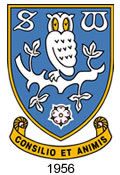 white
shirts so played in hooped jerseys instead, a style they had previously
worn in the reign of Queen Victoria.
white
shirts so played in hooped jerseys instead, a style they had previously
worn in the reign of Queen Victoria.
During the 1950s, the "Owls" (the club's
home is in the Owlerton district of Sheffield) were promoted and relegated
between the top two divisions with bewildering frequency. 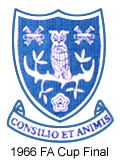 The club's first official crest was adopted in 1956 but was never used on the team's shirts. This featured an owl, which would become the regular motif of future crests along with the club's Latin motto (which translates as "By Wisdom and Courage").
The club's first official crest was adopted in 1956 but was never used on the team's shirts. This featured an owl, which would become the regular motif of future crests along with the club's Latin motto (which translates as "By Wisdom and Courage").
The 1960s were spent in the First Division and included an FA Cup final appearance in 1966 (in which the old crest appeared for the first and last time). This period saw different versions of the traditional stripes being trialled for a few matches in 1962 and in 1965, in a complete departure from Wednesday's traditional look, a smart blue shirt with white sleeves was adopted. In 1970 Wednesday were relegated and in 1975 they dropped into the Third Division for the first time.
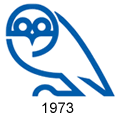 The striped shirts were reinstated in 1972, now for the first time with blue shorts, and the following season a stylised outline of an owl appeared on the players' shirts. This became one of the most iconic of all the "animal badges" and has been worn (apart from a break 1995-99) ever since in one form or another.
The striped shirts were reinstated in 1972, now for the first time with blue shorts, and the following season a stylised outline of an owl appeared on the players' shirts. This became one of the most iconic of all the "animal badges" and has been worn (apart from a break 1995-99) ever since in one form or another.
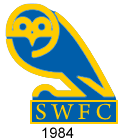 In 1980 the Owls were promoted back to Division Two and
only four years later the club was back in the First Division. At this stage the crest was modified to include the club's initials. This badge appeared in blue and gold, as shown, or in white.
In 1980 the Owls were promoted back to Division Two and
only four years later the club was back in the First Division. At this stage the crest was modified to include the club's initials. This badge appeared in blue and gold, as shown, or in white.
Apart from
one season in Division Two (1990-91), Wednesday became firmly established
at the top for the next twenty years. Ironically it was while they were in the Second Division that Wednesday won a rare trophy, beating Manchester United in the League Cup final. In the 1992-93 season they visited Wembley four 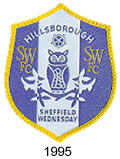 times for a League Cup Final, FA Cup semi-final final and replay. However, they ended the season without adding any more silverware to the trophy cabinet.
times for a League Cup Final, FA Cup semi-final final and replay. However, they ended the season without adding any more silverware to the trophy cabinet.
In 1995 a new crest was adopted with an altogether more traditional feel to it. The original version had a blue and white background, echoing the team's traditional striped shirts but this was replaced by a plain white background in 1997.
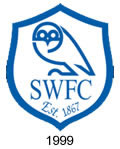 In 1999 the previous crest was replaced by a simplified version that reintroduced the popular, stylised owl as the centrepiece.
In 1999 the previous crest was replaced by a simplified version that reintroduced the popular, stylised owl as the centrepiece.
Wednesday began another downward cycle that took them to the depths of the third tier in 2003. After narrowly avoiding relegation to the basement in 2004, Wednesday returned to the second tier (now the Championship) via the play-offs in 2005. After several campaigns of mixed fortunes, the club was relegated to League One on the last day of the 2009-10 season.
Superstitious supporters favour a blue central stripe on the players' shirts, regarding white central stripes as unlucky.
In a landmark deal in England, Wednesday and Sheffield United shared the same sponsors 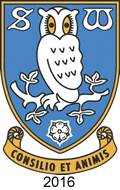 in 2011-12. Wednesday wore the logo of a Volkswagen dealership on their home shirts and that of Westfield Health Insurance Company on their away shirts while United reversed the arrangement. This followed concern expressed by local businesses that by sponsoring one club and not the other some supporters would be alienated from their brand. Similar concerns had led to Celtic and Rangers sharing sponsorship over a decade earlier.
in 2011-12. Wednesday wore the logo of a Volkswagen dealership on their home shirts and that of Westfield Health Insurance Company on their away shirts while United reversed the arrangement. This followed concern expressed by local businesses that by sponsoring one club and not the other some supporters would be alienated from their brand. Similar concerns had led to Celtic and Rangers sharing sponsorship over a decade earlier.
In January 2016 and after consultations with supporters, Wednesday's owner Dejphon Chansiri, announced that the club's original crest from 1956 would be revived for the 2016-17 season. This would be the first time that the badge had featured regularly on the team shirts. Many supporters were dismayed when it was revealed that the new crest would appear on an all-blue strip quite unlike anything worn previously in the club's long history.
The following season marked Wednesday's 150th anniversary and a special set of strips was commissioned. Curiously the first choice shirt was a reproduction of the admittedly smart version worn 1965-72, one of the rare periods when the club departed from their traditional stripes. These were manufactured in-house with an unknown brand, Elev8. Elev8 Clothing Ltd and Elev8 Energy Drink Ltd were registered with Companies' House in August 2017 with Wednesday's chairman, Dejphon Chansiri, being the sole director.
In July 2020 the club were docked 12 points for breaching the EFL's profitability and sustainability rules. This followed Chansiri purchasing Wednesday's stadium for £60 million in June 2019. This was recorded in the club's accounts for the previous year, turning a £35.4 million loss into a modest profit. (Losses are limited to £39 million over a rolling three-year period.) Inexplicably the independent disciplinary commission applied the points penalty to the following season allowing the club to avoid immediate relegation. The penalty was later reduced to six points on appeal. On the final day of the 2020-21 season, during which they had three managers, Wednesday were in fact relegated, ending a nine-year spell in the Championship.
Sources
- (a) The Owls - this is an excellent hobby site run by Andrew Drake with a superb history section including a graphic kit history
- (b) Sheffield Wednesday Official Website
- (c) Sporting Heroes
- (d) Football Focus
- (e) Bury
FC - Images of Sport (Peter Cullen 1998) | Buy from Amazon.co.uk
- (f) The Football Encyclopaedia (Associated Sporting Press 1934) Information provided by Arthur Fergus
- (g) Association of Football Statisticians - provided by Pete Wyatt
- (h) Lee Allott
- (i) Pete's Picture Palace
- (j) David King
- (k) Sheffield Wednesday 1867-1967 (Images of Sport - Nick Johnson 2003)
- (l) Alick Milne
- (m) Steven Draper
- (n) www.chrishobbs.com
- (o) Mark Wild
- (p) Christopher Worrall
- (q) Roger Law
- (r) David Rice
- (s) Paul Clarkson
- (t) Simon Monks
- (u) Andrew Drake (Sheffield Wednesday History)
- (v) Keith Ellis (HFK Research Associate)
- (w) Mark Etches
- (x) Bulldog1867
- (y) Darrin Foss
- (z) The Romance of The Wednesday 1867-1926 (Richard Sparling 1997) provided by Ben Bebbington
- (A) Nick Bruzon
- (B) Old Football Shirts
- (C) Paul Nagel.
- (D) Charles Alcock's Football Annuals 1873, 1876, 1877, 1879, 1880, 1881 researched by Robin Horton
- (E) Star Green 'Un (24 March 1917 & 29 September 1917), submitted by Richard Essen
- (F) Mark Etches
Crests are the property of Sheffield Wednesday FC




